Rashes on the face or body cause us a lot of problems. This not only spoils your appearance, but often causes physical suffering, especially if you have a large subcutaneous pimple, like a lump. How to get rid of it, what to put on it? Indeed, in some cases there is simply no way to see a doctor for help. There are many recipes for getting rid of acne, but when using them, you should be especially careful, and we will talk about this later in the article.

How does a subcutaneous pimple occur?
So, you discovered that a large subcutaneous pimple has appeared on your body, like a lump. How to get rid of it? In order to receive proper treatment, you need to have a good understanding of what exactly is happening in the body at the moment. Let's find out how these acne occur.
To protect the epidermis from the effects of microbes, as well as to soften the surface of the skin and the hairs growing on it, the human body produces sebum. It is secreted through special sebaceous glands, but sometimes clots form in their lumen, which disrupt this process and allow bacteria and microbes to multiply. This is how inflammation begins. Externally, this manifests itself in the form of red, painful bumps that slowly increase in size, causing a lot of discomfort. And often the time from the onset of pimple formation to its maturation is calculated in weeks.
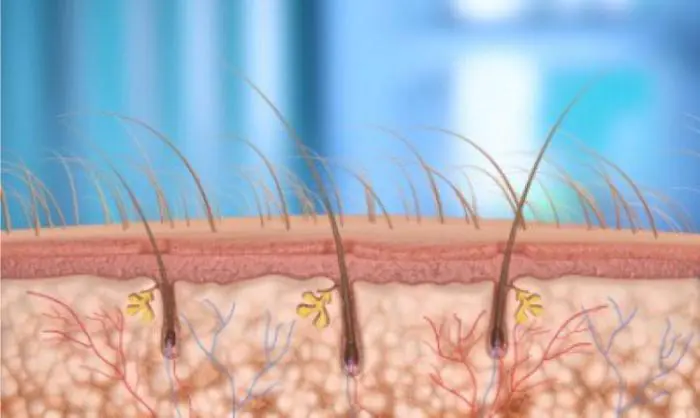
Causes of acne
Slowly maturing, the described neoplasm grows, forcing you to painfully think: “Wow, what a subcutaneous pimple - like a lump! How to get rid of this nightmare? And most often, a person in such conditions decides to take radical measures - squeeze it out and that’s it! But this is precisely this – a very careless, moreover, frivolous decision. After all, the causes of acne can be very different:
- insufficient compliance with the rules of hygiene and skin care;
- hormonal imbalances;
- increased proliferation of pathogenic microflora living on the skin;
- insufficient or unbalanced nutrition;
- disturbances in the functioning of the gastrointestinal tract;
- allergic reaction, etc.
This means that the approach to treatment should be different in each specific case. In addition, even if you successfully squeeze out one pimple, you will not be healed: new ones will appear very soon, and if you also get an infection, the problem will develop into a serious inflammatory process, and ugly scars will remain on the skin, which, by the way, will be difficult to get rid of much more difficult. So what to do?

A subcutaneous pimple appears like a lump - how to get rid of it?
Photos showing the skin defects we are considering can hardly be called pleasant. And if we add the discomfort a person experiences when touching a problem area (and sometimes there is no need to even touch - the inflamed area already hurts), then it will not be surprising that the sufferer wants to get rid of the nasty tubercle as soon as possible. However, it is highly not recommended to engage in amateur activities! As mentioned above, only a dermatologist can tell you the true cause of your acne after conducting the necessary examinations. He will also prescribe adequate therapy. And often treatment comes down not only to the fight against skin rashes, but also covers the underlying ailment. Therefore, prepare for the fact that the effect will not be quick, but by getting rid of the main problem, you will provide yourself with clean and healthy skin.
And, as a rule, the doctor not only prescribes medications, but also clearly outlines the rules that need to be followed in the future.
- Mandatory treatment of the affected area with antiseptics and provision of necessary body hygiene.
- Exclusion from the diet of fatty, spicy and smoked foods.
- Women are encouraged to avoid cosmetics that clog pores.
If you do not have the opportunity to contact a specialist, you can also resort to home remedies (at the same time adhering to the rules listed above).
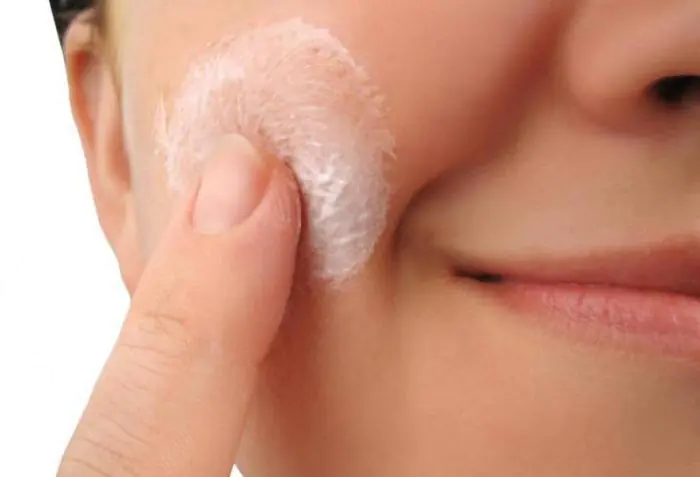
How to treat acne at home
If a dense subcutaneous pimple (like a bump) pops up, many publications on this topic will tell you how to get rid of it at home. The main thing is to be careful and not overdo it.
Since large pimples ripen very slowly, to speed up the process and draw out the pus, doctors advise using ichthyol ointment, Vishnevsky ointment or Levomekol. The affected area is lubricated with one of the listed products, and a piece of cotton wool or bandage is covered on top and sealed with a bandage. This compress is best done at night.
An ordinary aloe leaf can also be very effective. It is applied to the pimple with the cut part and fixed with a band-aid.
Salt lotions are quite effective. For them, dilute 2 tbsp in a glass of boiling water. l. salt and, after cooling slightly, apply with a cotton swab to the inflamed area. By the way, this procedure should be done several times a day.
It is also recommended to wipe acne with alcohol tincture of propolis. But you shouldn’t apply a cotton swab with it to the formations for a long time - you can get a burn on an already inflamed area of skin.
What to do if acne appears on the back
In some cases, the occurrence of rashes is especially problematic, for example, if you have a painful subcutaneous pimple like a lump on your back. How to get rid of it?
It is quite difficult to apply special ointments or lotions to the skin on your back (of course, if you do not have a reliable assistant at home). In such cases, it is usually recommended to take baths with chamomile infusion and sea salt, and brewer's yeast is prescribed internally. They are produced in both dry and liquid form. Liquid ones are considered more effective. In order to get rid of furunculosis, they are taken for a month 3 times a day 15 minutes before meals. And although this product has no contraindications, it will still be better if you consult your doctor first.
By the way, to combat rashes on the face, as well as for oily and porous skin, masks made from brewer's yeast are used - they help regulate the production of sebum and disinfect the surface of the skin. This way, you don't have to worry about getting a subcutaneous pimple (like a bump).
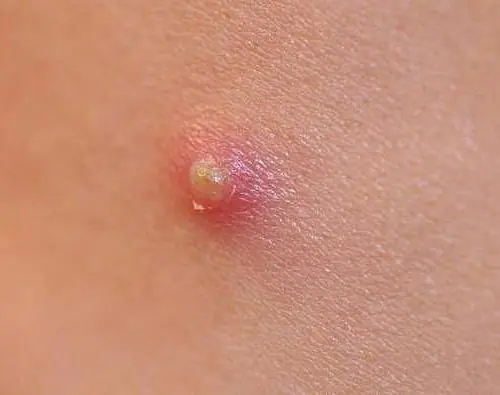
How to get rid of rashes on the cheek and the whole body?
When treating subcutaneous acne, you should remember that the treatment must be comprehensive. That is, using only baths with medicinal herbs or ointments, you will not achieve the desired result. Procedures must be combined and combined so that the effect is maximum.
For example, what should you do if a subcutaneous pimple pops up on your back like a bump? How to get rid of it? The problem is aggravated by the fact that the skin here is rougher than on the face, in addition, the areas of inflammation are constantly irritated due to contact with clothing. There is only one way out - try to act in several directions at once: baths, lotions, compresses, observing hygiene rules, using ointments.
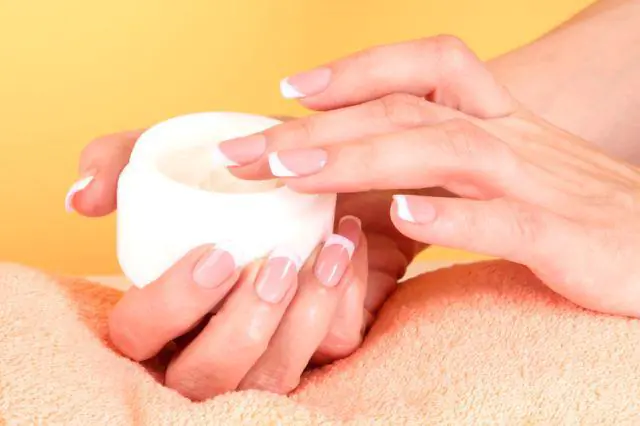
How to achieve good results from acne treatment
So, let's repeat once again what to do if you have a subcutaneous pimple like a lump. How to get rid of new rashes?
- Wear things made from natural fabrics, avoid clothes that are tough and irritating to the skin, thick seams and tight straps.
- Take the baths described above, and always start with your hair to avoid clogging your pores with the substances in your shampoo and conditioner.
- Don't use a washcloth that's too hard, but you don't want one that's very soft either.
- Do not get carried away with solarium and sunbathing, avoid massage oils.
- Take brewer's yeast and eat more fiber-rich foods.
- And, of course, wipe problem areas with salicylic alcohol and apply anti-inflammatory ointments to them.
With enough patience and persistence, you will achieve good results.
Acne on the face or various parts of the body is often a consequence of internal disorders that arise due to errors in lifestyle, exposure to adverse factors or developing diseases. One of these problems is subcutaneous formations, which are not just an unpleasant aesthetic defect, but also a possible symptom of pathological processes occurring in the body.
What are subcutaneous acne
The process of formation of subcutaneous skin is directly related to the excessive production of sebum, which accumulates in the sebaceous ducts. It is a breeding ground for bacteria that multiply inside the sebaceous glands and provoke subcutaneous inflammation. As a result of the inflammatory process, a hard ball (bump) appears on the skin, which hurts when pressed and, unlike skin rashes such as pimples or acne, is not squeezed out in the usual way.
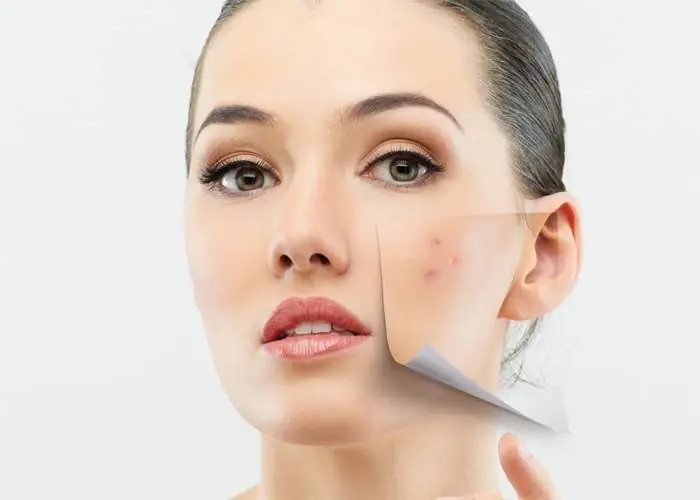
Inflammation affects the inner layers of the skin, and its superficial keratinized layer creates an obstacle to the normal cleaning of the sebaceous ducts. For this reason, it is difficult to get rid of subcutaneous acne, whether it is small white rashes or one large inflamed subcutaneous area. Such formations are located in the deep layers of the skin and “ripe” for a very long time, and therefore it is impossible to remove accumulations of sebum and pus from them using conventional methods.
Reasons for appearance
Having understood what subcutaneous acne is and what is the mechanism of its formation, it is necessary to find out what causes it. The main reason for the appearance of such rashes is a disruption in the process of sebum secretion, and it develops under the influence of a number of internal pathologies or external adverse influences. Why do subcutaneous patches appear? Experts name the following factors that contribute to or provoke their formation:
- improper or insufficient skin care;
- hormonal imbalance associated with puberty, pregnancy, contraceptives, or endocrine diseases;
- overheating or hypothermia of the body;
- poor nutrition;
- abuse of peeling or tanning;
- disturbances in the gastrointestinal tract;
- reduced immunity;
- metabolic disease;
- hereditary predisposition;
- gynecological diseases;
- subcutaneous mite;
- bad habits (tobacco use, alcohol use).
On the face
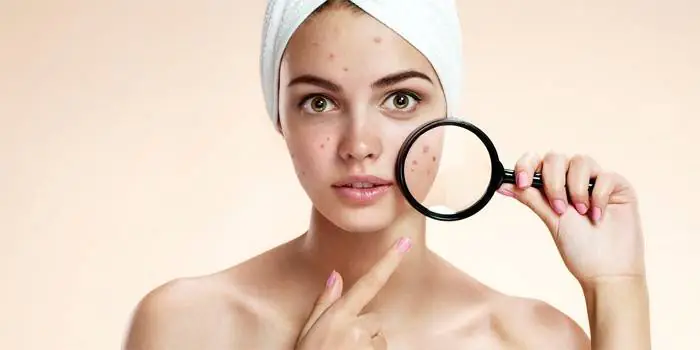
Problems with facial skin, manifested in the form of subcutaneous acne, often indicate hormonal imbalances in the body:
- If small bumps appear on the face that do not go away for a long time, this may be a consequence of developing endocrine pathologies or temporary hormonal imbalance due to natural causes (adolescence, pregnancy).
- In women, white pimples on the face can occur due to ovarian dysfunction caused by polycystic disease. In this case, they are localized on the chin and on the lower cheeks.
- In people with oily or thick skin, internal acne on the face appears due to excessive sebum production and can be located anywhere - on the forehead, nose, cheekbones, chin.
- Painful lumps on the lips that initially look like pimples can be a sign of herpes.
On the back
The appearance of subcutaneous lesions on the back can also be a consequence of sudden hormonal changes, but this phenomenon is often observed in athletes or people leading an active lifestyle. During physical activity, the back constantly sweats, and this contributes to the contamination of the sebaceous ducts and the accumulation of sebum in them, leading to the development of the inflammatory process and the appearance of acne. Find out how to remove acne on a woman's back.
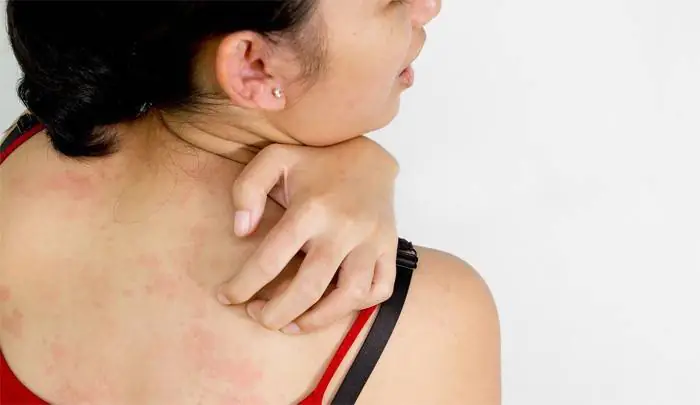
On the neck
Rashes on the neck, located in the deep layers of the epidermis, rarely occur, since the skin in this part of the body is thin. If such pimples appear in this area, it is recommended to undergo a comprehensive medical examination, since they may be associated with diseases of the internal organs or the beginning of the development of pathological processes in the body.
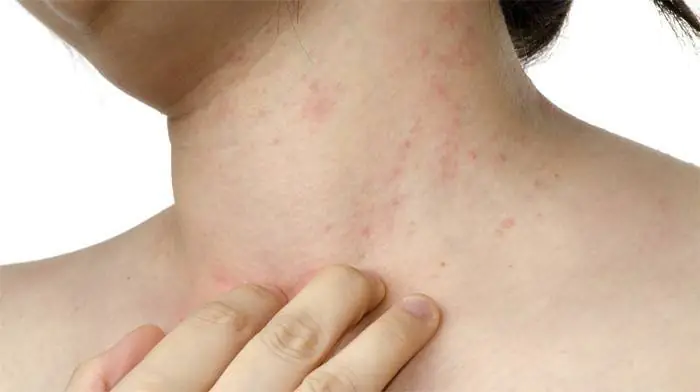
On hands
The appearance of subcutaneous rashes on the hands may indicate endocrine disorders, allergies, and hereditary diseases. If acne appears below the elbow or in the area of the hands, this should be especially alarming, because in these areas there are fewer sebaceous glands and the appearance of skin formations on them can indicate serious pathologies and malfunctions of the body.

On the labia
Subcutaneous formations in the genital area in many cases occur due to hypothermia of the body. They may appear after a cold, swimming in cold water or improper hardening. Other possible causes are microtraumas that occur during hair removal in the bikini area, as well as wearing synthetic underwear, which irritates the skin and causes it to overheat.
Subcutaneous bumps all over the body
If subcutaneous rashes are located throughout the body, this may be a manifestation of a genetic disease - hereditary lipomatosis. With this disease, bumps can appear on any part of the body - neck, arms, legs, stomach, back. This disorder requires careful examination and long-term complex therapy, and sometimes surgical intervention.
How to get rid of internal pimple
If there are a lot of subcutaneous formations and they do not go away for a long time, it is unlikely that you will be able to get rid of them on your own. In such cases, consultation with a dermatologist and special therapy are necessary. The same applies to such an unpleasant manifestation as acne on the face located deep under the skin, the treatment of which must be carried out under the supervision of a specialist.
However, if the pimple is single and has appeared recently, you can try to remove it without seeking medical help by using available pharmacy and home remedies. How to remove the subcutaneous tissue? Such pimples “ripen” for a long time, over several weeks, so attempts to squeeze them out will be unsuccessful. How to treat the skin to speed up this process and prevent complications from developing?
Ointment
An excellent remedy for combating subcutaneous skin are Vishnevsky ointment, Levomekol, and zinc ointment. How to pull out a pimple using these drugs? Ointments should be applied to the affected areas at least 2 times a day. In addition, compresses made from ichthyol ointment have a good effect, drawing the contents of the subcutaneous tissue out. It is recommended to apply them at night.
Cream for subcutaneous acne
When treating subcutaneous rashes, creams with an antibacterial and healing effect are helpful, allowing you to quickly stop the inflammatory process and accelerate tissue regeneration in the affected area. The most effective products in this category, recommended for the fight against subcutaneous skin, are the creams “Baziron”, “Differin”, “Skinoren”, “Klenzit-S”.
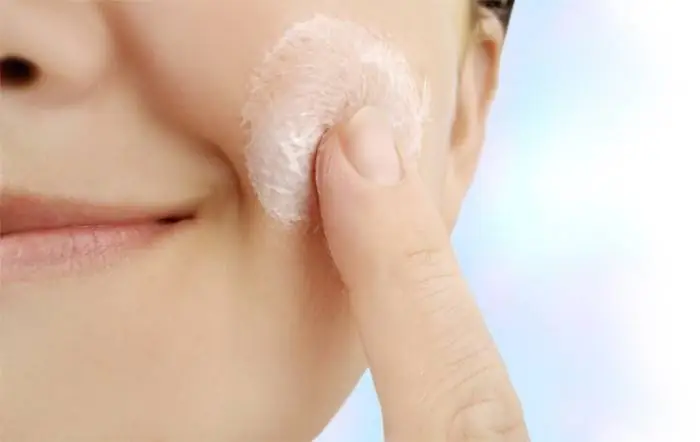
Treatment with folk remedies
Simple folk recipes that are available for use at home will help eliminate subcutaneous formations:
- Aloe compress. It helps well to get rid of such an unpleasant phenomenon as a long-lasting purulent pimple that cannot burst on its own. Cut an aloe leaf, apply it to the site of inflammation and secure with a bandage. It is most convenient to apply the compress at night.
- Tea tree oil. Apply it to your pimples every 3-4 hours for a few days until you notice improvement.
- Mask of oil and garlic. Lubricate the problem area with vegetable oil, and then precisely apply chopped garlic to the area of inflammation and place gauze soaked in hot water over it. Leave on for 20 minutes and rinse off.
How to squeeze a pimple
When deciding to squeeze out a pimple located deep under the skin, it is very important to remember the high risk of infection, even wider spread of rashes or scarring on the skin. A fully mature pimple can be squeezed out after first disinfecting your hands and treating the wound with an antibacterial solution. However, the removal of multiple formations must be entrusted to a dermatologist or cosmetologist.
Video: how to cure an internal pimple
Once and for all, special video materials will help you deal with the problem of subcutaneous rashes, in which this topic is covered in as much detail as possible. Experts talk about the main reasons for the appearance of such formations, provide photos of common types of rashes, explain how to deal with them and how to properly remove a pimple located in the deep layers of the epidermis.
Red subcutaneous pimples are a very unpleasant type of inflammatory skin changes. Their pathogenesis is always based on several reasons - one factor cannot lead to the appearance of acne.
It follows from this that an integrated approach is required to eliminate and prevent them. One-time measures that eliminate only one cause will help improve the appearance, but will not get rid of the problem for a long time.
Where do they come from?
The mechanism for the appearance of skin defects consists of two main components - disruption of the sebaceous glands and the addition of infection.
The sebaceous glands produce sebum, a substance that is necessary to soften the skin and give it elasticity. If it is produced in excess, the ducts of the sebaceous glands become clogged.
Sometimes this happens very close to the beginning of the duct, and then the “plug” is under the skin - a white subcutaneous pimple is formed. It is painless and does not cause any sensations other than an unpleasant appearance.
An infection can get into the blocked duct, and then the next stage of the disease begins - a red subcutaneous pimple.
This is an inflammation in which normal skin microflora takes part. A red pimple is painful when touched and may itch; the skin around it is healthy or red.
Reasons that lead to the above phenomena:
- hormonal pathologies;
- imbalance of normal microflora;
- poor nutrition;
- violation of personal hygiene rules;
- decreased immunity.
Video: Useful information
How do they look?
The earliest stage of diagnosing acne is carried out by the patient independently. To do this you need to look in the mirror. Negative changes will be visible immediately.
Red subcutaneous acne is characterized by a number of appearance features:
- relatively small size, especially in the early stages;
- bright red color in the flowering stage;
- pain when pressed;
- multiple lesions are possible, with the skin acquiring an unhealthy reddish color and lumpy appearance;
- may be accompanied by itching, peeling of the skin;
- if similar pimples appear on the face, they can spread to other areas of the body - neck, shoulders, torso;
- inability to squeeze out due to too deep location.
Often, several sebaceous glands are affected simultaneously. Multiple lesions look unattractive, are difficult to disguise with cosmetics and do not respond well to the usual home remedies - squeezing and treatment with antiseptics. To completely get rid of them, you need to consult a dermatologist.
How are red subcutaneous pimples diagnosed?
If such formations appear on the face, you need to consult a dermatologist. There is usually no urgent need for this, but acne is very unpleasant and does not go away on its own, so it is important to see a doctor. The specialist begins the diagnostic process with a detailed conversation.
He may ask the patient the following questions:
- about the features of skin care and hygiene;
- about the duration of the disease;
- types of cosmetics used by the patient;
- allergies and intolerances;
- nutritional characteristics;
- about chronic diseases of the gastrointestinal tract, endocrine system, immune system;
- frequency of colds;
- other inflammatory processes on the skin;
- bad habits.
All this can give a hint where to look for the cause of acne. Detailed and truthful answers will save the doctor and patient from the need for a lengthy diagnostic search and help reduce the number of necessary tests.
Laboratory methods require general and biochemical blood tests - they will show possible disorders of the gastrointestinal tract, liver and kidneys that could affect the condition of the skin.
You may also need a blood test for hormones - sex hormones, corticosteroids, thyroid hormones. These three groups most often cause deviations in appearance.
It is quite difficult to determine the type of pathogen - the pimple is located under the skin, and it is not possible to take a smear directly from it.
The doctor takes material for bacteriological analysis from the area of skin closest to the pimple. This method is necessary in order to identify the pathogen and determine which drug will be most effective in this case.
How to fight?
Eliminating acne requires a comprehensive approach. Both medicinal methods and recommendations for proper skin care and lifestyle changes are used.
Only a full impact on the body can completely lead the skin to a healthy and beautiful appearance.
If a big pimple on your butt hurts. You need to follow the link.
What to do with your facial skin?
The first thing you should pay attention to is facial care. During treatment (until the acne goes away), the patient needs to completely abandon decorative cosmetics in the area of inflammation.
Foundation, powder and other products do not always mask skin imperfections; moreover, they interfere with the effective cleansing of the ducts of the sebaceous glands, and acne will last longer.
Instead of decorative cosmetics, you should pay more attention to care products. You need to wash your face twice a day - in the morning and in the evening, and also every time after going outside or doing any dirty work.
In this case, you need to use not soap, but special gels and foams for washing. It is advisable to choose those that are designed to care for problem skin or fight acne.
You can use decoctions and infusions of medicinal herbs for washing. After washing, the skin is treated with miramistin or chlorhexidine.
Be sure to use nourishing or moisturizing creams daily. They are applied before bed, half an hour before going outside, 20 minutes after washing.
Once every 2-3 days you need to use cleansing facial scrubs - they will remove deep impurities, which are the main cause of acne. After using the scrub, you need to lubricate your face with moisturizer.
What to do with your lifestyle?
It is impossible to completely eliminate harmful factors. However, it is possible and necessary to reduce their impact on the body. First of all, this requires paying attention to nutrition.
You should limit your fat intake. Primarily of animal origin. Vegetable oils, on the contrary, will be useful - they contain vitamins A and E, which are necessary for the skin.
It is advisable to replace sweets with honey and fruits - this is much healthier for the skin. In addition, you should eat more well-digestible foods - dairy products, dietary meat and fish. Eggs are not on this list because their effect on the body is ambiguous.
Do I need to take medications?
If the causes of acne are chronic diseases, pathologies of the skin, immune, endocrine or digestive system, then they should be treated with medication. To prescribe medications, you need to consult a specialized specialist.
To treat acne itself, several groups of drugs are prescribed:
- intestinal sorbents and enzyme preparations improve the absorption of nutrients and reduce the amount of toxins entering the blood;
- anti-inflammatory drugs;
- vitamin preparations to correct the functioning of the sebaceous glands;
- hormonal medications to normalize hormonal levels;
- antibiotics to fight bacteria.
What can't you do?
Acne is not a dangerous disease, however, there are a number of things that are not recommended to be done - it is dangerous for the patient’s health.
- Squeezing pimples is ineffective and can cause additional infection. Lead to the spread of the inflammatory process;
- use skin antiseptics with a drying effect (alcohol, peroxide, potassium permanganate) - this will lead to even greater dysfunction of the sebaceous glands and deterioration of appearance;
- use foundation and powder - this reduces the effectiveness of treatment;
- apply burning and irritating substances to the skin - they do not cure acne, but can cause a severe inflammatory reaction;
- ignore doctor's recommendations.
These prohibitions are not difficult to implement, but will allow you to avoid complications of acne - scars, bumps on the skin, spread of the inflammatory process to neighboring tissues, boils and phlegmon.



